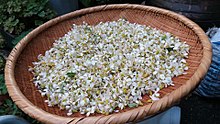Houttuynia cordata
| Houttuynia cordata | |
|---|---|

| |
| Scientific classification | |
| Kingdom: | Plantae |
| Clade: | Tracheophytes |
| Clade: | Angiosperms |
| Clade: | Magnoliids |
| Order: | Piperales |
| Family: | Saururaceae |
| Genus: | Houttuynia |
| Species: | H. cordata
|
| Binomial name | |
| Houttuynia cordata | |
Houttuynia cordata, also known as fish mint, fish leaf, rainbow plant, chameleon plant, heart leaf, fish wort, or Chinese lizard tail, is one of two species in the genus Houttuynia (the other being H. emeiensis). It is a flowering plant native to Southeast Asia.[1] It grows in moist, shady locations.[2] It was named after Martinus Houttuyn.
Growth
Houttuynia cordata is a
It is considered an invasive plant because of its ability to regrow rhizomes from any segment of its foliage.[3]
Cultivation

Houttuynia cordata grows in moist to wet soil or slightly submerged in water, as long as it is exposed partially or fully to the sun.[2][1] It can become invasive in gardens and difficult to eradicate as their roots run deep and actively spread. It propagates by division.
It is usually found in one of its cultivated forms in temperate gardens. The 'Chameleon' variety (synonymous with H.cordata 'Court Jester', 'Tricolour', and 'Variegata') is slightly less vigorous than the parent species, with stubbier leaves mottled in both yellow and red. Another common variety, 'Flore Pleno', has masses of white bracts and retains the vigor of the parent species.
Houttuynia cordata has been naturalized in North America.[4]
Usage
Culinary use

It is commonly grown as a leaf vegetable, and is used as a fresh herbal garnish.[2] The leaf has an unusual taste from its volatile oil decanoyl acetaldehyde, a taste that is often described as "fishy", earning it the nickname "fish mint".
In northeastern India, the leaves are commonly used in salads,
In Vietnamese cuisine, the plant is called diếp cá and is used with grilled meat and noodle salad dishes.[5] Fish mint may be used as a garnish with several Vietnamese dishes, such as gỏi cuốn, stir-fried beef with fish mint salad, and bánh xèo.[6]

Zhé'ěrgēn (Chinese: 折耳根, "broken ear-root") is the edible rhizome of Houttuynia cordata (yúxīngcǎo; 魚腥草; "fish-smelling grass") with a fresh, spicy, peppery flavour that is used in southwestern Chinese cuisine, i.e. that of Guizhou, Sichuan, Yunnan and western Guangxi. Typically the leaves are eaten in Sichuan and the root in Guizhou. Zhé'ěrgēn fried with larou (cured pork belly) is one of the staple dishes of Guizhou. uses:
- part of the extensive fried rice cuisine of Guizhou
- a condiment to migan and mixiannoodles when served in broth
- as a component of dipping sauces used with the Jianshuitradition of barbecued tofu
- raw consumption as part of cold-tossed salads, when it is most frequently combined with coriander, vinegar, fresh chilli, and soy sauce.
Traditional medicine
Houttuynia cordata was used in traditional Chinese medicine, including by Chinese scientists in an attempt to treat SARS[7] and various other disorders,[8] although there is no high-quality clinical research to confirm such uses are safe or effective, as of 2018. When administered via injection, H. cordata can cause severe allergic reactions.[9]
Aroma profile
Chemical compounds that contribute to the aroma of H. cordata include
See also
- Kampo herb list
- Sichuan cuisine
- Yunnan cuisine
References
- ^ a b c d "Houttuynia cordata, Thunb". KewScience, The Royal Horticultural Society, UK. 2018. Retrieved 8 October 2018.
- ^ a b c d e "Houttuynia cordata Thunb". Plants for a Future. 2012. Retrieved 9 April 2018.
- ^ "Houttuynia cordata (Chameleon Plant, Rainbow Plant) | North Carolina Extension Gardener Plant Toolbox". plants.ces.ncsu.edu. Retrieved 29 September 2020.
- ^ Global Invasive Species Database: Houttuynia cordata, accessed 2008-07-06
- ^ Vietnamese Herbs: Fish Mint, Accessed 9 October 2018.
- ^ NPR Inc.:Banh Xeo (Sizzling Crepes), Accessed 10 October 2018
- PMID 18479853.
- PMID 24600193.
- S2CID 25810338.
- PMID 16819207.
- PMID 17373437.
- .
External links
 Data related to Houttuynia cordata at Wikispecies
Data related to Houttuynia cordata at Wikispecies- Flora, The Gardener's Bible, ABC Publishing, Ultimo, NSW, Australia, 2006 ISBN 0-7333-1439-2
